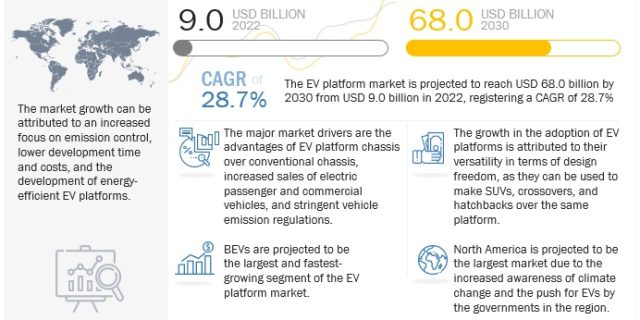
Increasing fuel prices and decreased emissions have made EVs a more attractive option in recent years. According to Global EV Outlook, EVs including BEVs & PHEVs, doubled in 2021 and reached 6.6 million units. Despite the supply chain issues and recession across Western countries, Electric cars sales rose strongly in 2022 and exceeded 10 million, ~14% of cars sold were electric. According to IEA, electric car sales are expected to reach 13 million units by the end of 2023. The global automotive industry is shifting towards a greener and sustainable future, so OEMs, system and component suppliers are investing in innovative technologies complying with the changing regulatory landscape.
Need For Electric Vehicle Modular Platform
Modular EV platforms offer versatility, accommodating sedan, hatchback, SUV, and utility vehicle models that can be built on a single platform, saving time and costs. Bodywork and chassis adapt to diverse needs, from compact to luxury, pick-up trucks to buses. These platforms are designed so that the EV battery packs are installed under the floor, motor positioning between tires, and efficient thermal management along platform sidewalls and bottom. Companies are developing comprehensive EV platforms, encompassing batteries, suspension, brakes, steering, and thermal systems. For instance, in September 2022, Williams Advanced Engineering introduced a high-performance EV platform with a central carbon fiber structure, battery pack, adjustable sub-frames, steering, and motors.
Automotive OEMs are collaborating to develop EV platforms and reduce the cost required to develop the EV platforms. Moreover, some OEMs are purchasing chassis from the EV platform manufacturers to develop vehicle cabins on the EV platform. For instance, In September 2022, VIA Motors received a purchase order for 2,000 Class 3 VIA electric vehicle platform cabs from Pegasus Specialty Vehicles. These platforms will build Type A school buses, electric shuttles, and paratransit buses.
Request Free Sample Report @ https://www.marketsandmarkets.com/requestsampleNew.asp?id=127463561
Alternatively, EV platform manufacturers are also developing platforms for CVs with long-width chassis, high battery capacity, and long-distance range, which can run on a single charge. They are also developing software-defined vehicles and long-range battery capacity platforms. These platforms will be manufactured under its Integrated Modular Architecture (IMA) system, a shared hardware and software platform for its vehicles.
Conclusion
EV demand is booming globally and with the development of modular platforms, OEMs can develop a flexible supply chain to meet the increase in EV demand. The modular platforms would not only reduce production times but also help in improving their profits. Furthermore, partnerships between EV platform manufacturers and OEMs can reduce cost, profitability issues, and burden of R&D expense, tooling, and plants without impacting choice in model variants. The growth in the EV platform market would also create opportunities in adjacent markets such as drive-by-wire (steer-by-wire, brake-by-wire, fly-by-wire, etc.) as these systems would create more space for cabins.
Inquire Before Buying @ https://www.marketsandmarkets.com/Enquiry_Before_BuyingNew.asp?id=127463561

